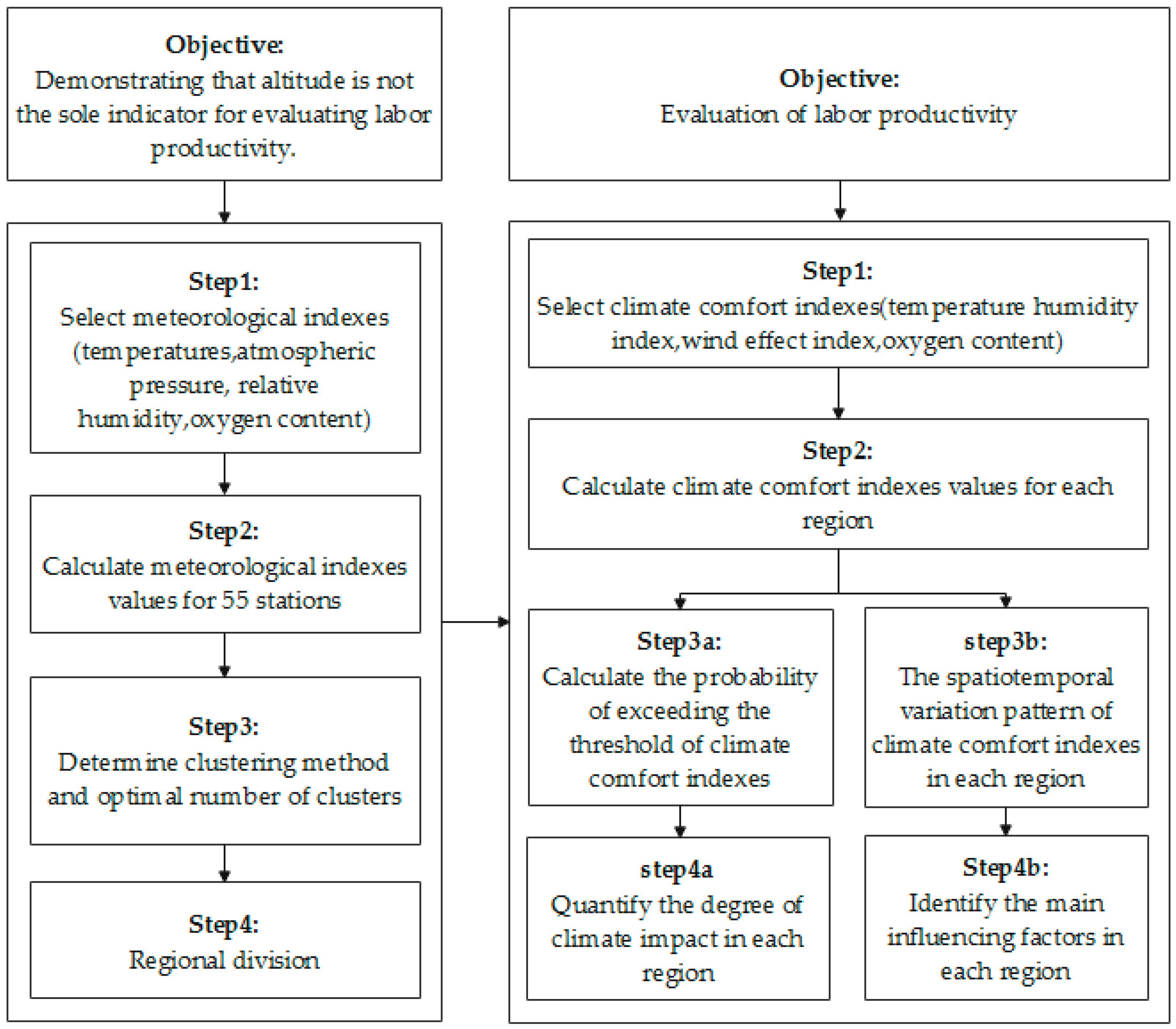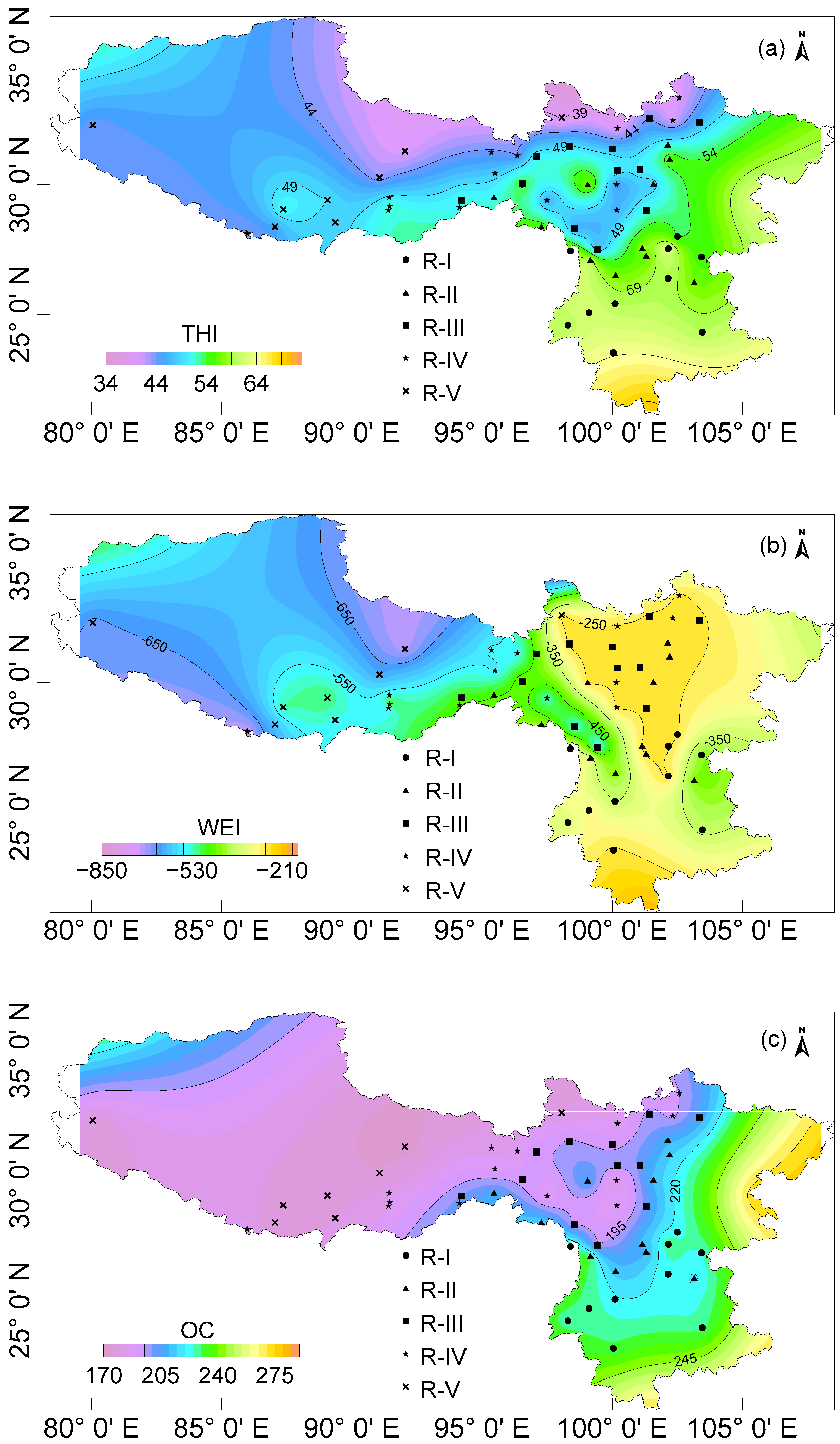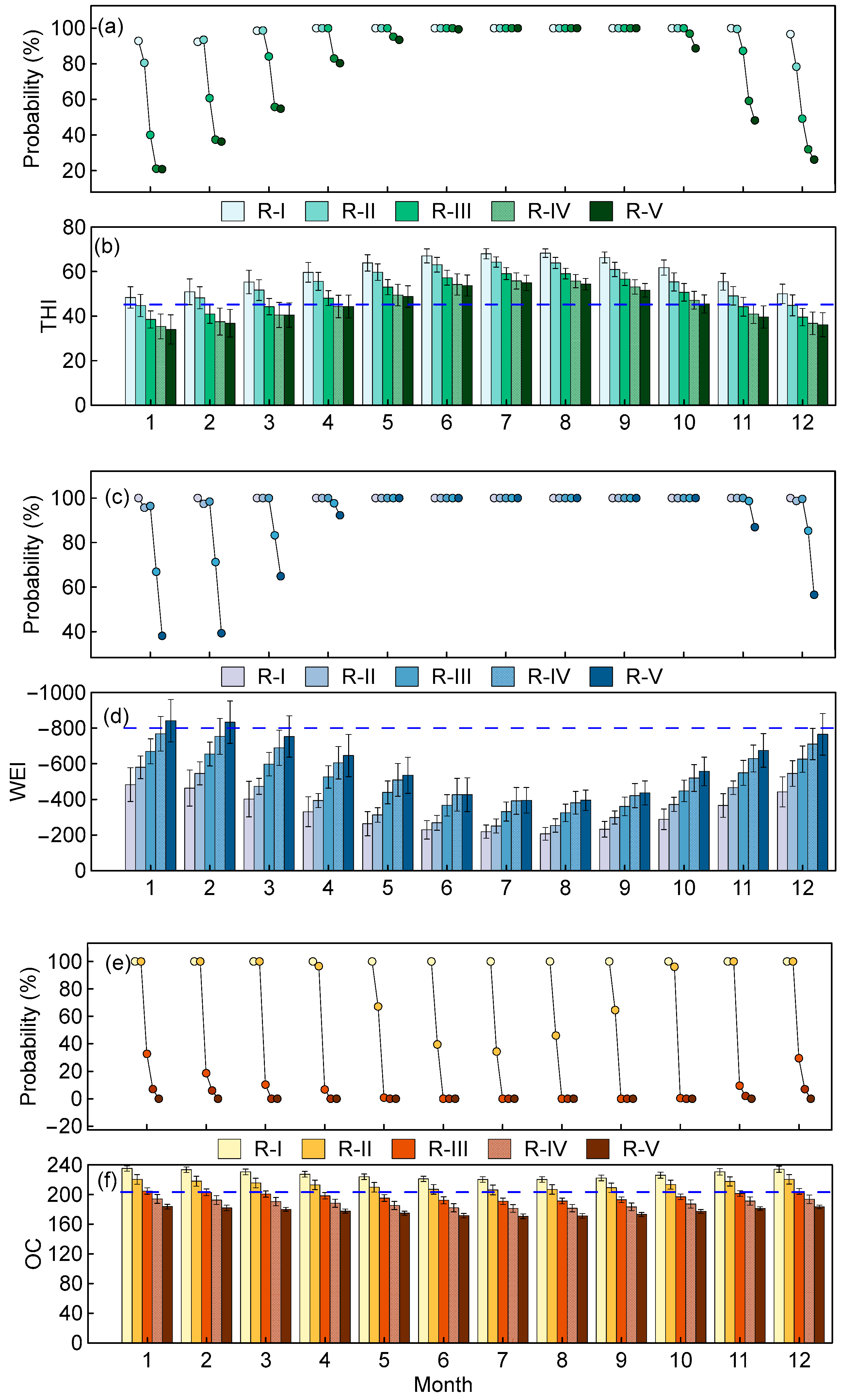Assessing the Impact of Climate Comfort on Labor Productivity in Hydropower Engineering Construction in Southwest China
Abstract
1. Introduction
2. Research Area and Methods
2.1. Research Area and Data Source
2.1.1. Research Area
2.1.2. Data Source
2.2. Methods
2.2.1. Cluster Analysis of Stations
K-Means Cluster
The Optimal Number of Clusters
2.2.2. Evaluation of Labor Productivity
Selecting the Climate Comfort Index
Process for Evaluating Labor Productivity
3. Results and Discussion
3.1. Cluster Stations and Altitude Analysis
3.2. The Spatiotemporal Variations in Climate Comfort
3.3. The Impact of CCI on Labor Productivity in Different Regions
3.4. Altitude and Climate Comfort in Altitude in Assessing Labor Productivity
4. Limitations and Implications
5. Conclusions
Author Contributions
Funding
Data Availability Statement
Acknowledgments
Conflicts of Interest
Abbreviations
| PIO2 | Partial pressure of inspiratory oxygen |
| CGCQ | Chinese Hydropower Construction Quota |
| CCI | Climate Comfort Index |
| ET | Effective Temperature |
| PET | Physiological Equivalent Temperature |
| THI | Temperature Humidity Index |
| WEI | Wind Effect Index |
| OC | Oxygen Content |
| UTCI | Universal Thermal Climate Index |
| PMV-PPD | Predicted Mean Vote-Predicted Percent Dissatisfied |
| WCI | wind cold index |
References
- Zheng, T.; Qiang, M.; Chen, W.; Xia, B.; Wang, J. An externality evaluation model for hydropower projects: A case study of the Three Gorges Project. Energy 2016, 108, 74–85. [Google Scholar] [CrossRef]
- Cheng, G.; Zhao, C.; Iqbal, N.; Gülmez, Ö.; Işik, H.; Kirikkaleli, D. Does energy productivity and public-private investment in energy achieve carbon neutrality target of China? J. Environ. Manag. 2021, 298, 113464. [Google Scholar] [CrossRef] [PubMed]
- Li, X.-Z.; Chen, Z.-J.; Fan, X.-C.; Cheng, Z.-J. Hydropower development situation and prospects in China. Renew. Sustain. Energy Rev. 2018, 82, 232–239. [Google Scholar] [CrossRef]
- Ni, H.; Zhao, J.; Peng, X.; Chen, G. Estimating the economic impact of large hydropower projects: A dynamic multi-regional computable general equilibrium analysis. Water Policy 2022, 24, 1343–1365. [Google Scholar] [CrossRef]
- Heravi, G.; Eslamdoost, E. Applying artificial neural networks for measuring and predicting construction-labor productivity. J. Constr. Eng. Manag. 2015, 141, 04015032. [Google Scholar] [CrossRef]
- Nasirzadeh, F.; Kabir, H.M.D.; Akbari, M.; Khosravi, A.; Nahavandi, S.; Carmichael, D.G. ANN-based prediction intervals to forecast labour productivity. Eng. Constr. Archit. Manag. 2020, 27, 2335–2351. [Google Scholar] [CrossRef]
- Yi, W.; Chan, A.P.C. Effects of Heat Stress on Construction Labor Productivity in Hong Kong: A Case Study of Rebar Workers. Int. J. Environ. Res. Public Health 2017, 14, 1055. [Google Scholar] [CrossRef] [PubMed]
- Hashiguchi, N.; Sengoku, S.; Kubota, Y.; Kitahara, S.; Lim, Y.; Kodama, K. Age-Dependent Influence of Intrinsic and Extrinsic Motivations on Construction Worker Performance. Int. J. Environ. Res. Public Health 2021, 18, 111. [Google Scholar] [CrossRef] [PubMed]
- Rathnayake, A.; Middleton, C. Systematic Review of the Literature on Construction Productivity. J. Constr. Eng. Manag. 2023, 149, 03123005. [Google Scholar] [CrossRef]
- Li, X.; Chow, K.H.; Zhu, Y.; Lin, Y. Evaluating the impacts of high-temperature outdoor working environments on construction labor productivity in China: A case study of rebar workers. Build. Environ. 2016, 95, 42–52. [Google Scholar] [CrossRef]
- Larsson, R.; Rudberg, M. Impact of Weather Conditions on In Situ Concrete Wall Operations Using a Simulation-Based Approach. J. Constr. Eng. Manag. 2019, 145, 05019009. [Google Scholar] [CrossRef]
- Guo, C.; Xu, J.; Wang, M.; Yan, T.; Yang, L.; Sun, Z. Study on oxygen supply standard for physical health of construction personnel of high-altitude tunnels. Int. J. Environ. Res. Public Health 2016, 13, 64. [Google Scholar] [CrossRef] [PubMed]
- Wu, P.; Yang, F.; Zheng, J.; Wei, Y. Evaluating the highway tunnel construction in western sichuan plateau considering vocational health and environment. Int. J. Environ. Res. Public Health 2019, 16, 4671. [Google Scholar] [CrossRef] [PubMed]
- Shi, P.; Chen, Y.; Zhang, A.; He, Y.; Gao, M.; Yang, J.; Mao, R.; Wu, J.; Ye, T.; Xiao, C.; et al. Factors contribution to oxygen concentration in Qinghai-Tibetan Plateau. Chin. Sci. Bull. 2019, 64, 715–724. [Google Scholar] [CrossRef]
- Guo, D.; Li, G.; Hu, N.; Hou, J. System dynamics analysis of man-machine efficacy in plateau mines. IEEE Access 2021, 9, 18072–18084. [Google Scholar] [CrossRef]
- Hua, N.; Huang, H.; Zhang, X. Investigating the working efficiency of typical work in high-altitude alpine metal mining areas based on a SeqGAN-GABP mixed algorithm. Adv. Civ. Eng. 2021, 2021, 9941415. [Google Scholar] [CrossRef]
- Pigliautile, I.; Casaccia, S.; Morresi, N.; Arnesano, M.; Pisello, A.L.; Revel, G.M. Assessing occupants’ personal attributes in relation to human perception of environmental comfort: Measurement procedure and data analysis. Build. Environ. 2020, 177, 106901. [Google Scholar] [CrossRef]
- Ortiz, M.A.; Kurvers, S.R.; Bluyssen, P.M. A review of comfort, health, and energy use: Understanding daily energy use and wellbeing for the development of a new approach to study comfort. Energy Build. 2017, 152, 323–335. [Google Scholar] [CrossRef]
- Zhao, M.; Zhu, M.; Chen, Y.; Zhang, C.; Cai, W. The uneven impacts of climate change on China’s labor productivity and economy. J. Environ. Manag. 2024, 351, 119707. [Google Scholar] [CrossRef]
- Bueno, A.M.; de Paula Xavier, A.A.; Broday, E.E. Evaluating the connection between thermal comfort and productivity in buildings: A systematic literature review. Buildings 2021, 11, 244. [Google Scholar] [CrossRef]
- Cui, W.; Cao, G.; Park, J.H.; Ouyang, Q.; Zhu, Y. Influence of indoor air temperature on human thermal comfort, motivation and performance. Build. Environ. 2013, 68, 114–122. [Google Scholar] [CrossRef]
- Zare, S.; Hasheminejad, N.; Shirvan, H.E.; Hemmatjo, R.; Sarebanzadeh, K.; Ahmadi, S. Comparing Universal Thermal Climate Index (UTCI) with selected thermal indices/environmental parameters during 12 months of the year. Weather. Clim. Extrem. 2018, 19, 49–57. [Google Scholar] [CrossRef]
- Wu, F.; Yang, X.; Shen, Z.; Yi, Z. Long-term trends and spatiotemporal variations of climate comfort in China during 1966–2016. Therm. Sci. 2020, 24, 2445–2453. [Google Scholar] [CrossRef]
- National Meteorological Information Center of China. Available online: http://data.cma.cn (accessed on 18 December 2021).
- Jain, A.K. Data clustering: 50 years beyond K-means. Pattern Recognit. Lett. 2010, 31, 651–666. [Google Scholar] [CrossRef]
- Mahlstein, I.; Knutti, R. Regional climate change patterns identified by cluster analysis. Clim. Dyn. 2010, 35, 587–600. [Google Scholar] [CrossRef]
- Wang, Z.; Chen, Y.; Zhou, M.; Wu, J.; Zhang, M. A clustering method with target supervision for the thermal climate division of residential buildings in the Hot Summer and Cold Winter Area of China. J. Build. Eng. 2021, 43, 103156. [Google Scholar] [CrossRef]
- Zhou, K.; Yang, S. Effect of cluster size distribution on clustering: A comparative study of k-means and fuzzy c-means clustering. Pattern Anal. Appl. 2020, 23, 455–466. [Google Scholar] [CrossRef]
- Chen, T.; Wang, W.; La, B. Study on oxygen content change Lhasa. Plateau Mt. Meteorol. Res. 2010, 30, 65–67. [Google Scholar] [CrossRef]
- Maulik, U.; Bandyopadhyay, S. Performance evaluation of some clustering algorithms and validity Iindices. IEEE Trans. Pattern Anal. Mach. Intell. 2002, 24, 1650–1654. [Google Scholar] [CrossRef]
- Liu, Y.; Li, Z.; Xiong, H.; Gao, X.; Wu, J. Understanding of internal clustering validation measures. In Proceedings of the 2010 IEEE International Conference on Data Mining, Sydney, Australia, 13–17 December 2010; pp. 911–916. [Google Scholar] [CrossRef]
- Durugkar, S.R.; Raja, R.; Nagwanshi, K.K.; Kumar, S. Introduction to data mining. In Data Mining and Machine Learning Applications; Raja, R., Nagwanshi, K.K., Kumar, S., Laxmi, K.R., Eds.; Wiley: Hoboken, NJ, USA, 2022; pp. 1–19. [Google Scholar] [CrossRef]
- Yuan, R. An improved K-means clustering algorithm for global earthquake catalogs and earthquake magnitude prediction. J. Seismol. 2021, 25, 1005–1020. [Google Scholar] [CrossRef]
- Brake, R.; Bates, G. A Valid Method for Comparing Rational and Empirical Heat Stress Indices. Ann. Occup. Hyg. 2002, 46, 165–174. [Google Scholar] [CrossRef] [PubMed]
- Yu, D.-D.; Li, S.; Guo, Z.-Y. Evaluating the Tourist Climate Comfortable Period of China in a Changing Climate. Adv. Meteorol. 2020, 2020, 8886316. [Google Scholar] [CrossRef]
- Cheung, T.; Schiavon, S.; Parkinson, T.; Li, P.; Brager, G. Analysis of the accuracy on PMV—PPD model using the ASHRAE Global Thermal Comfort Database. Build. Environ. 2019, 153, 205–217. [Google Scholar] [CrossRef]
- Höppe, P. The physiological equivalent temperature—A universal index for the biometeorological assessment of the thermal environment. Int. J. Biometeorol. 1999, 43, 71–75. [Google Scholar] [CrossRef]
- Jendritzky, G.; de Dear, R.; Havenith, G. UTCI—Why another thermal index? Int. J. Biometeorol. 2012, 56, 421–428. [Google Scholar] [CrossRef]
- Zhong, L.; Yu, H.; Zeng, Y. Impact of climate change on Tibet tourism based on tourism climate index. J. Geogr. Sci. 2019, 29, 2085–2100. [Google Scholar] [CrossRef]
- Liu, Q.; Wang, Z.; Xu, S. Climate suitability index for city tourism in China. Resour. Sci. 2007, 1, 133–141. [Google Scholar] [CrossRef]
- Terjung, W.H. Physiologic climates of the conterminous united states: A bioclimatic classification based on man. Ann. Assoc. Am. Geogr. 1966, 56, 141–179. [Google Scholar] [CrossRef]
- Liang, C.; Zheng, G.; Zhu, N.; Tian, Z.; Lu, S.; Chen, Y. A new environmental heat stress index for indoor hot and humid environments based on Cox regression. Build. Environ. 2011, 46, 2472–2479. [Google Scholar] [CrossRef]
- Andargie, M.S.; Azar, E. An applied framework to evaluate the impact of indoor office environmental factors on occupants’ comfort and working conditions. Sustain. Cities Soc. 2019, 46, 101447. [Google Scholar] [CrossRef]
- Asadi, I.; Mahyuddin, N.; Shafigh, P. A review on indoor environmental quality (IEQ) and energy consumption in building based on occupant behavior. Facilities 2017, 35, 684–695. [Google Scholar] [CrossRef]
- Ma, L.; Sun, G.; Xie, Y.; Long, M. A Study on Variations of the Tourism Climate Comfort Degree in Five Typical Cities in Eastern China during the Last 50 Years. Resour. Sci. 2010, 32, 1955–1962. [Google Scholar]
- Cheng, Q.-p.; Zhong, F.-l. Evaluation of tourism climate comfort in the Grand Shangri-La region. J. Mt. Sci. 2019, 16, 1452–1469. [Google Scholar] [CrossRef]
- Liu, Y.; Huang, L.; Song, C.; Wang, D.; Suolang, B.; Duan, G. Effect of hypoxia on human cognitive ability and indoor oxygen environment demand for sojourners at high altitude. Build. Environ. 2021, 194, 107678. [Google Scholar] [CrossRef]
- Coleshaw, S.; Van Someren, R.; Wolff, A.; Davis, H.; Keatinge, W. Impaired memory registration and speed of reasoning caused by low body temperature. Surv. Anesthesiol. 1984, 55, 27–31. [Google Scholar] [CrossRef]
- Parsons, K.C. Environmental ergonomics: A review of principles, methods and models. Appl. Ergon. 2000, 31, 581–594. [Google Scholar] [CrossRef] [PubMed]
- Faerevik, H.; Hansen, J.H.; Wiggen, O.; Sandsund, M. Cognitive performance during night work in the cold. Front. Physiol. 2021, 12, 768517. [Google Scholar] [CrossRef] [PubMed]
- Coca, A.; Williams, W.J.; Roberge, R.J.; Powell, J.B. Effects of fire fighter protective ensembles on mobility and performance. Appl. Ergon. 2010, 41, 636–641. [Google Scholar] [CrossRef] [PubMed]
- Taylor, N.A.S.; Peoples, G.E.; Petersen, S.R. Load carriage, human performance, and employment standards. Appl. Physiol. Nutr. Metab. 2016, 41, S131–S147. [Google Scholar] [CrossRef]
- Sirangelo, B.; Caloiero, T.; Coscarelli, R.; Ferrari, E.; Fusto, F. Combining stochastic models of air temperature and vapour pressure for the analysis of the bioclimatic comfort through the Humidex. Sci. Rep. 2020, 10, 11395. [Google Scholar] [CrossRef]
- Wolkoff, P.; Azuma, K.; Carrer, P. Health, work performance, and risk of infection in office-like environments: The role of indoor temperature, air humidity, and ventilation. Int. J. Hyg. Environ. Health 2021, 233, 113709. [Google Scholar] [CrossRef] [PubMed]
- Benton, D.; Jenkins, K.T.; Watkins, H.T.; Young, H.A. Minor degree of hypohydration adversely influences cognition: A mediator analysis. Am. J. Clin. Nutr. 2016, 104, 603–612. [Google Scholar] [CrossRef] [PubMed]
- Liu, J.; Xin, Z.; Huang, Y.; Yu, J. Climate suitability assessment on the Qinghai-Tibet Plateau. Sci. Total Environ. 2022, 816, 151653. [Google Scholar] [CrossRef] [PubMed]
- Shen, W.; Tian, J.; Zhang, T.; Zhang, H.; Zhang, H. Research on the efficiency reduction of manual labor in Tibet power grid engineering. Electr. Power Technol. 2010, 19, 16–19. [Google Scholar]
- Shi, P.; Chen, Y.; Ma, H.; Ye, T.; Tang, H.; Wang, J.a. Further research on the factors contributing to oxygen concentration over the Qinghai-Tibet Plateau. Chin. Sci. Bull. 2021, 66, 4028–4035. [Google Scholar] [CrossRef]
- Liu, R.; Shi, P.; Tang, H.; Wang, J.a.; Zhao, C.; Zhu, W. Vegetation oxygen production and its contribution rate to near-Surface atmospheric oxygen concentration on the Qinghai-Tibet Plateau. Acta Geogr. Sin. 2023, 78, 1136–1152. [Google Scholar]
- Yu, Z.; Sun, G.; Feng, Q.; Luo, Z. Tourism climate comfort and risk for Qinghai-Tibet Plateau. Resour. Sci. 2014, 36, 2327–2336. [Google Scholar]




| Temperature–Humidity Index (THI) | Wind-Efficiency Index (WEI) | Oxygen Content (OC) | ||||
|---|---|---|---|---|---|---|
| Classification | Body Sensation | Classification | Body Sensation | Classification | Body Sensation | |
| Relative Oxygen Content | Absolute Oxygen Content | |||||
| <40 | Extremely cold and uncomfortable | <−1200 | Extremely cold wind | 21% | 271 | |
| 40–45 | Cold and uncomfortable | −1000–−1200 | Cold wind | |||
| 45–55 | Slightly cold and uncomfortable | −800–−1000 | Slightly cold wind | <19.5% | <252 | Tired and weak |
| 55–60 | Cool and comfortable | −600–−800 | Cool wind | |||
| 60–65 | Cool and very comfortable | −300–−600 | Comfortable wind | <12% | <206 | Difficulty in breathing |
| 65–70 | Warm and comfortable | −200–−300 | Warm wind | |||
| 70–75 | Rather warm and comfortable | −50–−200 | No sensible wind | <10% | <155 | Incapacitated |
| 75–80 | Sultry and uncomfortable | 80–−50 | Hot wind | |||
| 80 | Extremely sultry and uncomfortable | >80 | Uncomfortable wind | |||
| Regions | Province | Stations (Altitude) | Mean Altitude |
|---|---|---|---|
| R-I | Yunnan | Baoshan (1651 m), Gongshan (1587 m), Licang (1503 m), Luxi (1706 m), Tengchong (1697 m), Zhaotong (1950 m), Dali (1992 m) | 1760 m |
| Sichuan | Huli (1789 m), Xichang (1593 m), Zhaojue (2134 m) | ||
| R-II | Yunnan | Weixi (2326 m), Huize (2190 m), Lijiang (2382 m) | 2440 m |
| Sichuan | Batang (2590 m), Kangding (2616 m), Muli (2425 m), Xiaojin (2439 m), Yanyuan (2545 m), Maerkang (2666 m) | ||
| Tibet | Chayu (2329 m), Bomi (2337 m) | ||
| R-III | Yunnan | Deqin (3321 m), Xianggelila (3278 m) | 3146 m |
| Sichuan | Aba (3276 m), Daofu (2959 m), Dege (3185 m), Ganzi (3395 m), Jiulong (2931 m), Songpan (2883 m), Xinlong (2999 m) | ||
| Tibet | Basu (3562 m), Changdu (3316 m), Linzhi (2993 m) | ||
| R-IV | Tibet | Dingqing (3874 m), Leiwuqi (3811 m), Luolong (3641 m), Milin (2951 m), Mozhugongka (3805 m), Qiongjie (3741 m), Zuogong (3781 m), Nielamu (3811 m), Zedang (3562 m) | 3677 m |
| Sichuan | Daocheng (3729 m), Hongyuan (3493 m), Litang (3941 m), Ruoergai (3443 m), Seda (3896 m) | ||
| R-V | Sichuan | Shiqu (4201 m) | 4192 m |
| Tibet | Dangxiong (4201 m), Naqu (4508 m), Dingri (4301 m), Jiangzi (4041 m), Lazi (4001 m), Nanmulin (4001 m), Shihequan (4208 m) |
| Regions | THI | WEI | OC | |||
|---|---|---|---|---|---|---|
| Mean | Comfort Probability (100%) | Mean | Comfort Probability (100%) | Mean | Comfort Probability (100%) | |
| R-I | 59.61 ± 8.10 | 98.4% | −326.80 ± 121.30 | 100% | 226.98 ± 6.60 | 100% |
| R-II | 55.15 ± 8.06 | 95.9% | −411.13 ± 135.88 | 99.3% | 213.01 ± 8.18 | 78.6% |
| R-III | 49.29 ± 8.20 | 85.1% | −490.84 ± 138.65 | 99.5% | 197.54 ± 6.41 | 9.0% |
| R-VI | 45.92 ± 8.73 | 73.4% | −567.04 ± 162.77 | 91.9% | 187.55 ± 7.17 | 1.8% |
| R-V | 45.03 ± 8.76 | 70.7% | −604.65 ± 190.45 | 81.5% | 177.09 ± 5.48 | 0% |
Disclaimer/Publisher’s Note: The statements, opinions and data contained in all publications are solely those of the individual author(s) and contributor(s) and not of MDPI and/or the editor(s). MDPI and/or the editor(s) disclaim responsibility for any injury to people or property resulting from any ideas, methods, instructions or products referred to in the content. |
© 2024 by the authors. Licensee MDPI, Basel, Switzerland. This article is an open access article distributed under the terms and conditions of the Creative Commons Attribution (CC BY) license (https://creativecommons.org/licenses/by/4.0/).
Share and Cite
Jian, F.; Guo, Q.; Liu, Q.; Feng, C.; Liu, J. Assessing the Impact of Climate Comfort on Labor Productivity in Hydropower Engineering Construction in Southwest China. Buildings 2024, 14, 2398. https://doi.org/10.3390/buildings14082398
Jian F, Guo Q, Liu Q, Feng C, Liu J. Assessing the Impact of Climate Comfort on Labor Productivity in Hydropower Engineering Construction in Southwest China. Buildings. 2024; 14(8):2398. https://doi.org/10.3390/buildings14082398
Chicago/Turabian StyleJian, Feihong, Qi Guo, Qian Liu, Cong Feng, and Jia Liu. 2024. "Assessing the Impact of Climate Comfort on Labor Productivity in Hydropower Engineering Construction in Southwest China" Buildings 14, no. 8: 2398. https://doi.org/10.3390/buildings14082398
APA StyleJian, F., Guo, Q., Liu, Q., Feng, C., & Liu, J. (2024). Assessing the Impact of Climate Comfort on Labor Productivity in Hydropower Engineering Construction in Southwest China. Buildings, 14(8), 2398. https://doi.org/10.3390/buildings14082398







